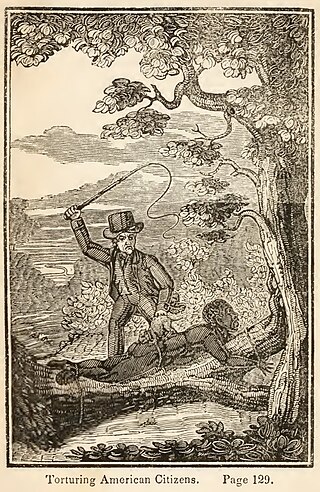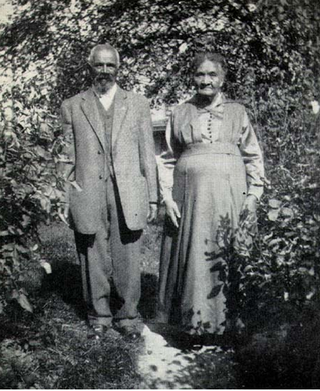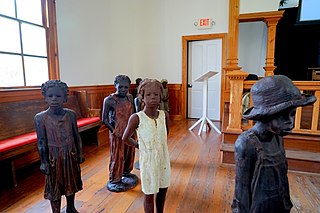
The legal institution of human chattel slavery, comprising the enslavement primarily of Africans and African Americans, was prevalent in the United States of America from its founding in 1776 until 1865, predominantly in the South. Slavery was established throughout European colonization in the Americas. From 1526, during the early colonial period, it was practiced in what became Britain's colonies, including the Thirteen Colonies that formed the United States. Under the law, an enslaved person was treated as property that could be bought, sold, or given away. Slavery lasted in about half of U.S. states until abolition in 1865, and issues concerning slavery seeped into every aspect of national politics, economics, and social custom. In the decades after the end of Reconstruction in 1877, many of slavery's economic and social functions were continued through segregation, sharecropping, and convict leasing.

Paternalism is action that limits a person's or group's liberty or autonomy and is intended to promote their own good. Paternalism can also imply that the behavior is against or regardless of the will of a person, or also that the behavior expresses an attitude of superiority. Paternalism, paternalistic and paternalist have all been used as a pejorative for example in the context of societal and/or political realms and references.

Historians who address the origins of the American Civil War agree that the preservation of the institution of slavery was the principal aim of the 11 Southern states that declared their secession from the United States and united to form the Confederate States of America. However, while historians in the 21st century agree on the centrality of the conflict over slavery—it was not just "a cause" of the war but "the cause" according to Civil War historian Chris Mackowski—they disagree sharply on which aspects of this conflict were most important, and on the North’s reasons for refusing to allow the Southern states to secede. Proponents of the pseudo-historical Lost Cause ideology have denied that slavery was the principal cause of the secession, a view that has been disproven by the overwhelming historical evidence against it, notably the seceding states' own secession documents.
Eugene Dominic Genovese was an American historian of the American South and American slavery. He was noted for bringing a Marxist perspective to the study of power, class and relations between planters and slaves in the South. His book Roll, Jordan, Roll: The World the Slaves Made won the Bancroft Prize. He later abandoned the left and Marxism and embraced traditionalist conservatism. He wrote during the Cold War and his political beliefs were viewed by some as highly controversial at the time.

The internal slave trade in the United States, also known as the domestic slave trade, the Second Middle Passage and the interregional slave trade, was the mercantile trade of enslaved people within the United States. It was most significant after 1808, when the importation of slaves from Africa was prohibited by federal law. Historians estimate that upwards of one million slaves were forcibly relocated from the Upper South, places like Maryland, Virginia, Kentucky, North Carolina, Tennessee, and Missouri, to the territories and then-new states of the Deep South, especially Georgia, Alabama, Louisiana, Mississippi, and Arkansas.

The institution of slavery in North America existed from the earliest years of the colonial history of the United States until 1865 when the Thirteenth Amendment abolished slavery throughout the United States except as punishment for a crime. It was also abolished among the sovereign Indian tribes in Indian Territory by new peace treaties which the US required after the Civil War.

The history of slavery in Kentucky dates from the earliest permanent European settlements in the state, until the end of the Civil War. Kentucky was classified as the Upper South or a border state, and enslaved African Americans represented 24 percent by 1830, but declined to 19.5 percent by 1860 on the eve of the Civil War. The majority of enslaved people in Kentucky were concentrated in the cities of Louisville and Lexington, in the fertile Bluegrass Region as well the Jackson Purchase, both the largest hemp- and tobacco-producing areas in the state. In addition, many enslaved people lived in the Ohio River counties where they were most often used in skilled trades or as house servants. Few people lived in slavery in the mountainous regions of eastern and southeastern Kentucky. Those that did that were held in eastern and southeastern Kentucky served primarily as artisans and service workers in towns.

Invisible churches among enslaved African Americans in the United States were informal Christian groups where enslaved people listened to preachers that they chose without their slaveholder's knowledge. The Invisible churches taught a different message from white-controlled churches and did not emphasize obedience to slave masters. Some slaves could not contact invisible churches and others did not agree with an invisible church's message but many slaves were comforted by the invisible churches.

Slave breeding was the practice in slave states of the United States of slave owners to systematically force the reproduction of slaves to increase their profits. It included coerced sexual relations between male slaves and women or girls, forced pregnancies of female slaves, and favoring women or young girls who could produce a relatively large number of children. The objective was to increase the number of slaves without incurring the cost of purchase, and to fill labor shortages caused by the abolition of the Atlantic slave trade.

Peter Bruner was born a slave in Kentucky. He escaped enslavement to join the Union Army during the Civil War. After the war, he married and raised a family in Ohio. Collaborating with his daughter, he published his autobiography.

The treatment of slaves in the United States often included sexual abuse and rape, the denial of education, and punishments like whippings. Families were often split up by the sale of one or more members, usually never to see or hear of each other again.

The Cotton Plantation Record and Account Book is a best-selling and pioneering guide to farm accounting in the antebellum cotton-producing regions of the United States. It was first published in 1847 or 1848 by Thomas Affleck (1812–1868), a Scottish immigrant and owner of the Glenblythe Plantation in Gay Hill, Washington County, Texas. The book contains a detailed system, including blank tables to be filled in, that allowed plantation owners to track the efficiency of their production. It also includes essays on various aspects of plantation management, such as the proper care and discipline of slaves.

Following Robert Cavelier de La Salle establishing the French claim to the territory and the introduction of the name Louisiana, the first settlements in the southernmost portion of Louisiana were developed at present-day Biloxi (1699), Mobile (1702), Natchitoches (1714), and New Orleans (1718). Slavery was then established by European colonists.
Manisha Sinha is an Indian-born American historian, and the Draper Chair in American History at the University of Connecticut. She is the author of The Slave's Cause: A History of Abolition (2016), which won the Frederick Douglass Book Prize.

The history of slavery in Mississippi began when the region was still Mississippi Territory and continued until abolition in 1865. The U.S. state of Mississippi had one of the largest populations of enslaved people in the Confederacy, third behind Virginia and Georgia. There were very few free people of color in Mississippi the year before the American Civil War: the ratio was one freedman for every 575 slaves.

This is a bibliography of works regarding the internal or domestic slave trade in the United States (1775–1865, with a measurable increase in activity after 1808, following the Act Prohibiting Importation of Slaves).

This is a glossary of American slavery, terminology specific to the cultural, economic, and political history of slavery in the United States

Bernard Kendig was an American slave trader, primarily operating in New Orleans. He sold enslaved people at comparatively low prices, and dealt primarily in and around Louisiana, rather than importing large numbers of enslaved people from the border states or Chesapeake region. Kendig was sued a number of times under Louisiana's redhibition (warranty) laws and accused of having willfully misrepresented the health or character of slaves he sold.
John Hagan was a well-known American interstate slave trader who operated slave jails in both Charleston and New Orleans, as well as maintaining strong business and personal ties to the Richmond slave markets. He partnered with his brothers Hugh Hagan and Alexander Hagan, as well as with his maternal uncles, Hugh McDonald and Alexander McDonald.

Jonathan Means Wilson, usually advertising as J. M. Wilson, was a 19th-century slave trader of the United States who trafficked people from the Upper South to the Lower South as part of the interstate slave trade. Originally a trading agent and associate to Baltimore traders, he later operated a slave depot in New Orleans. At the time of the 1860 U.S. census of New Orleans, Wilson had the second-highest net worth of the 34 residents who listed their occupation as "slave trader".
















